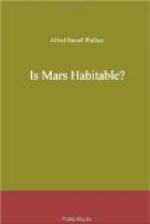Mr. Lowell’s Mathematical Investigation of the Problem.
But as this result has been held to be both improbable in itself and founded on no valid evidence, he has now, in the London, Edinburgh, and Dublin Philosophical Magazine of July 1907, published an elaborate paper of 15 pages, entitled A General Method for Evaluating the Surface-Temperatures of the Planets; with special reference to the Temperature of Mars, by Professor Percival Lowell; and in this paper, by what purports to be strict mathematical reasoning based on the most recent discoveries as to the laws of heat, as well as on measurements or estimates of the various elements and constants used in the calculations, he arrives at a conclusion strikingly accordant with that put forward in the recently published volume. Having myself neither mathematical nor physical knowledge sufficient to enable me to criticise this elaborate paper, except on a few points, I will here limit myself to giving a short account of it, so as to explain its method of procedure; after which I may add a few notes on what seem to me doubtful points; while I also hope to be able to give the opinions of some more competent critics than myself.
Mr. Lowell’s Mode of Estimating the Surface-temperature of Mars.
The author first states, that Professor Young, in his General Astronomy (1898), makes the mean temperature of Mars 223.6 deg. absolute, by using Newton’s law of heat being radiated in proportion to temperature, and 363 deg. abs. (=-96 deg. F.) by Dulong and Petit’s law; but adds, that a closer determination has been made by Professor Moulton, using Stefan’s law, that radiation is as the 4th_ power of the temperature, whence results a mean temperature of-31 deg. F. These estimates assume identity of atmospheric conditions of Mars and the Earth.
But as none of these estimates take account of the many complex factors which interfere with such direct and simple calculations, Mr. Lowell then proceeds to enunciate them, and work out mathematically the effects they produce:
(1) The whole radiant energy of the sun on striking a planet becomes divided as follows: Part is reflected back into space, part absorbed by the atmosphere, part transmitted to the surface of the planet. This surface again reflects a portion and only the balance left goes to warm the planet.
(2) To solve this complex problem we are helped by the albedoes or intrinsic brilliancy of the planets, which depend on the proportion of the visible rays which are reflected and which determines the comparative brightness of their respective surfaces. We also have to find the ratio of the invisible to the visible rays and the heating power of each.
(3) He then refers to the actinometer and pyroheliometer, instruments for measuring the actual heat derived from the sun, and also to the Bolometer, an instrument invented by Professor Langley for measuring the invisible heat rays, which he has proved to extend to more than three times the length of the whole heat-spectrum as previously known, and has also shown that the invisible rays contribute 68 per cent, of the sun’s total energy.[9]




